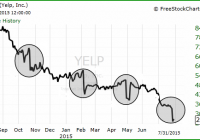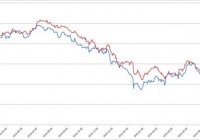How To Catch A Falling Knife
Summary The “falling knife” stock is increasingly common. The current economic environment increases risk in falling stocks. One long-established investment technique can minimize the risk. Falling knife: A security or industry in which the current price or value has dropped significantly in a short period of time. A falling knife security can rebound, or it can lose all of its value, such as in the case of company bankruptcy where equity shares become worthless. –Investopedia Remember Boston Chicken? Inspired by the heady days of the late ’90s and my personal effort to improve their top line, I watched BOST decline in price and finally made a major share purchase when it was so low I could not resist. To this day I maintain that no company can go broke trying to sell too much fat, salt, and sugar to the American public. This axiom was overcome by BOST’s incestuous finances and the practice of selling one dollar of chicken for 95 cents, which led to bankruptcy in 1998. A $50 check from the subsequent class action lawsuit did little to assuage my five figure loss. There were many lessons to be had from this experience. The one I want to concentrate on is the value of dollar cost averaging, or DCA, in purchasing stocks that are declining in price. DCA refers to planned purchases in multiple increments over time, in contrast to a one time purchase of the full investment. If I had used DCA with Boston Chicken, my loss would have been much less severe. DCA is useful in many circumstances, but its benefits are magnified in cases where a stock is in a significant decline. The Falling Knife Scenario The classic falling knife scenario consists of an abrupt price change. Yelp is a particularly hair-raising example: A broader definition of “falling knife” is any stock that is in a clear price decline over a period of time. Under this definition there are many falling knives among today’s investment choices. Every day articles appear on Seeking Alpha enthusiastically recommending a purchase because stock X is N per cent off its high. Readers will often note that such articles have appeared since a decline began. Here are three companies in the falling knife category that have had bullish articles all the way down: American Capital Agency (NASDAQ: AGNC ), Emerson Electric (NYSE: EMR ), Chevron (NYSE: CVX ): How long and how severe these declines will be no one knows. At losses from 52 week highs of 22%, 19%, and 30% for EMR, AGNC and CVX there could still be a lot of air underneath them. Other widely held falling knives include: Exxon Mobil (NYSE: XOM ). Intel (NASDAQ: INTC ), Caterpillar (NYSE: CAT ), Freeport-McMoRan (NYSE: FCX ), BHP Billiton (NYSE: BBL ) (NYSE: BHP ), National Oilwell Varco (NYSE: NOV ), and 3M (NYSE: MMM ). The DCA Effect Using Chevron as an example the usefulness of DCA is clear. An investment of $30,000 when CVX had declined 10% from its high of $130 would buy 256 shares: Date Price Investment Shares 10/02/2015 $117 $30,000 256 Value 08/01/15 $88 $22,528 256 An investment in three increments over equal time periods would buy 293 shares: Date Price Investment Shares 10/02/2015 $117 $10,000 85 03/01/2015 $105 $10,000 95 08/01/20015 $88 $10,000 113 Value 08/01/15 $88 $25,784 293 The DCA approach buys 37 more shares, $3,256 more in value, and $159 more in annual income. If CVX returns to $130, the price at which it started, the difference in total value rises to $4,810. It is true that there is a possibility of losing out on some gains if a stock rises in value between purchases. But as Daniel Kahneman wrote in classic book Thinking, Fast and Slow : Losses loom larger than gains. The “loss aversion ratio” has been estimated in several experiments and is usually in the range of 1.5 to 2.5. For the average investor, the good feelings you get from gains are more than wiped out by the bad feelings from losses. Perhaps humans have an instinctual aversion to loss of capital. Why is DCA important now? DCA has strengths that apply to all circumstances, such as reducing risk and replacing emotion with discipline. In today’s markets its benefits are particularly important. After six years of almost uninterrupted rise in stock prices, recency bias is very strong. Recency bias causes investors to believe trends and patterns have observed in the recent past will continue in the future. Investors look at where a stock has been, not where it is going. Complacency among investors is high. New investors have with no experience of a declining market have an inflated sense of their stock-picking ability. Older investors, with six years of mostly positive experience, may think that their prowess has improved more than it has. Price declines reflect changes in the macroeconomic situation. Global growth estimates continue to be lowered. Money is no longer being added to the US system through quantitative easing, and as shown by Eric Parnell and others there has been a strong relationship between QE and stock market performance. In addition, numerous indicators have been flashing warning signs for some time. DCA is agnostic concerning market projections but economic changes do affect results. Conclusions The falling knife conundrum — what to do when a stock we like is falling — is increasingly common. The angel on one shoulder tells us to buy and the angel on the other shoulder tells us not to lose money. Dollar cost averaging is a way to resolve these different impulses. DCA is helpful in many situations, but particularly today when uncertainty is increasing and six years of successful stock-picking may have inflated both our confidence in the market and the perception of our abilities. DCA takes away the pressure of having to make a one-time purchase decision, allows us to act independently of market noise, and reduces risk. Disclosure: I/we have no positions in any stocks mentioned, but may initiate a long position in XOM EMR over the next 72 hours. (More…) I wrote this article myself, and it expresses my own opinions. I am not receiving compensation for it (other than from Seeking Alpha). I have no business relationship with any company whose stock is mentioned in this article.

